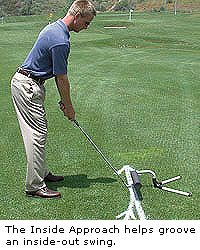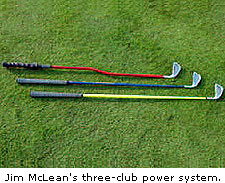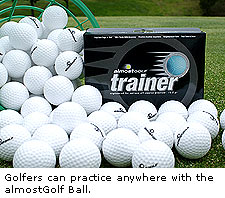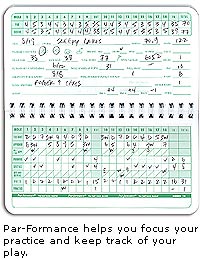 STICKS
& STONES STICKS
& STONES
Training Aids II:
|
|
The Inside Approach is a foot-long cylindrical foam cushion attached to a plastic stand. Jim Sowerwine, director of instruction at the Rick Smith Golf Academy at Tiburon in Naples, Fla., developed the elegantly simple device in order to provide visual and tactile feedback, forcing an inside swing-path. To use it, you place a golf ball under or slightly inside of the front of the cushion. If you “cast” the club outside on the downswing, you’ll hit the cushion. Likewise if you lift the club up too steeply at take-away, or on the follow-through. The accompanying video also explains how to use it to fix swings that are too far inside.
It takes a little while to get used to swinging under the cushion. Begin by teeing up the ball and using short irons. At first it is easy to let the cushion psych you out, which will cause you to hit lots of fat shots if the ball isn’t teed up. With practice, hitting off the turf or using woods is no problem
McLean Power System
 Developed
and pitched by Jim McLean, 1994 National PGA Teacher of the Year
and coach to a dozen touring pros, the McLean Power System (mcleanpowersystem.com,
(800) 847-9464, MSRP $190) consists of three progressively weighted
clubs and an instructional DVD. The heaviest club weighs three pounds,
and has a bent shaft and position-reinforcing grip. The weighting
scheme promotes an on-plane swing and keeps you from casting outside
on the downswing.
Developed
and pitched by Jim McLean, 1994 National PGA Teacher of the Year
and coach to a dozen touring pros, the McLean Power System (mcleanpowersystem.com,
(800) 847-9464, MSRP $190) consists of three progressively weighted
clubs and an instructional DVD. The heaviest club weighs three pounds,
and has a bent shaft and position-reinforcing grip. The weighting
scheme promotes an on-plane swing and keeps you from casting outside
on the downswing.
The second club in the set is a blue-shafted iron which is also heavier than a standard club, but you can still hit balls with it. After slow-motion swinging with the heavy club, this one feels relatively light, but it still promotes a proper swing-path and also builds strength. The third club is a yellow-shafted, lighter-than-normal iron, with which you can also hit balls. Once the heavy clubs have build strength and grooved the swing, this one lets you feel what a faster swing-speed feels like.
Although the weighted club system is sound, watching the DVD is like watching paint dry. It could have used another round or two of edits, and McLean should have rehearsed a bit more. His frequent stumbles and repeats add to the overall tedium.
Taking It to the Next Level with Roger Gunn
Roger Gunn is a veteran tour player and coach to several present tour standouts. His level-specific instructional series (golflevels.com, $30/each, or $100 for the five-part series) is unique in that it targets different skills for the beginner, 20-30 handicap., 12-19 handicap, 5-11 handicap, and 4-scratch golfer. This sort of approach is often lacking in most instructional programs or training devices.
In the 5-11 handicap installment, Gunn begins by pointing out something that only the very best players realize: “You don’t need to be perfect to shoot low scores. It’s more a matter of the quality of your misses and your short game.” Refreshing. In the DVD, Gunn covers finding a shot you can rely on, curving the ball, and trouble shots we all need to have in our repertoire.
It’s not nearly as bad as the McLean DVD, but this one suffers from a few production flaws. At times the camera work is bouncy, and we never did see where Gunn’s first shot—which he led up to with 10 minutes of narration—ended up. Gunn knows his stuff, but the ceaseless talking was a bit numbing.
almostGolf Ball
 In
sharp contrast to the previous instructional DVDs, the one produced
by the developers of the almostGolf Ball (almostgolf.com, (800)
998-1077, MSRP $12/doz.) called How to Play Golf Off the Course
and Not Get Arrested is actually entertaining. The extremely
goofy DVD promotes the company’s rather clever almostGolf Ball.
The ball weighs just 13.5 grams, and is made from a semi-hard polystyrene
that makes it safe around cars and windows—although if you teed
one up a few fee in front of a big window and hit it with a driver,
damage would almost certainly result.
In
sharp contrast to the previous instructional DVDs, the one produced
by the developers of the almostGolf Ball (almostgolf.com, (800)
998-1077, MSRP $12/doz.) called How to Play Golf Off the Course
and Not Get Arrested is actually entertaining. The extremely
goofy DVD promotes the company’s rather clever almostGolf Ball.
The ball weighs just 13.5 grams, and is made from a semi-hard polystyrene
that makes it safe around cars and windows—although if you teed
one up a few fee in front of a big window and hit it with a driver,
damage would almost certainly result.
The point of the light-hearted DVD, which features Bob Duval (Champions Tour player and father of David), is that one can use these balls to practice anywhere, any time. With a COR of .37, the balls behave like real golf balls: they spin, draw, and fade. But they won’t go more than just over 100 yards even with the biggest drive. So you can take them to the beach and practice sand shots, to the park (with the almostShag synthetic mini-mat) and work on wedge shots while your kids cavort on the jungle gym.
Since the best way to improve your game is to practice, and since finding time to get to the course is so difficult for most folks, this “practice anywhere” ball might just be the most practical product on the market.
On-Mark Impact Spray
Often, simpler is better when it comes to swing training aids. On-Mark Impact Spray (on-markusa.com, (800) 925-0020, MSRP $12) is a powdery yellow spray that you apply to the face of the club. Every hit leaves a mark in the powder, telling you where you struck the ball. The nice thing about the powder is that, unlike impact tape, it does not interfere with ball flight or distance, and one application can be used for up to 10 swings (as long as the grass isn’t deep and/or wet). And it wipes off the clubface without a trace when you’re done.
Par-Formance Golf Score Journal
 Nothing
replaces concentrated practice in honing your game. But it can be
tough to figure out or even remember what it is you need to be working
onto lower your scores. The Par-Formance Golf Score Journal (par-formance.com,
MSRP $10) is a sturdy, yardage-book sized log in which has space
to chronicle your stats for 20 rounds of golf.
Nothing
replaces concentrated practice in honing your game. But it can be
tough to figure out or even remember what it is you need to be working
onto lower your scores. The Par-Formance Golf Score Journal (par-formance.com,
MSRP $10) is a sturdy, yardage-book sized log in which has space
to chronicle your stats for 20 rounds of golf.
There are sections for goals, scoring, charts, notes, stroke savers, and rules. For each round, you can track everything from the weather to hole-by-hole club selections to your up-and-down attempts. PDA software of a similar nature is on the market, but it is much more expensive than the “old-fashioned” Par-Formance, and I just can’t see diddling with a PDA on the course. Stick with this system, and it will certainly help you focus on what you can do to lower scores, even without swing changes.
Any opinions expressed above are those of the writer and do not necessarily represent the views of the management. The information in this story was accurate at the time of publication. All contact information, directions and prices should be confirmed directly with the golf course or resort before making reservations and/or travel plans.